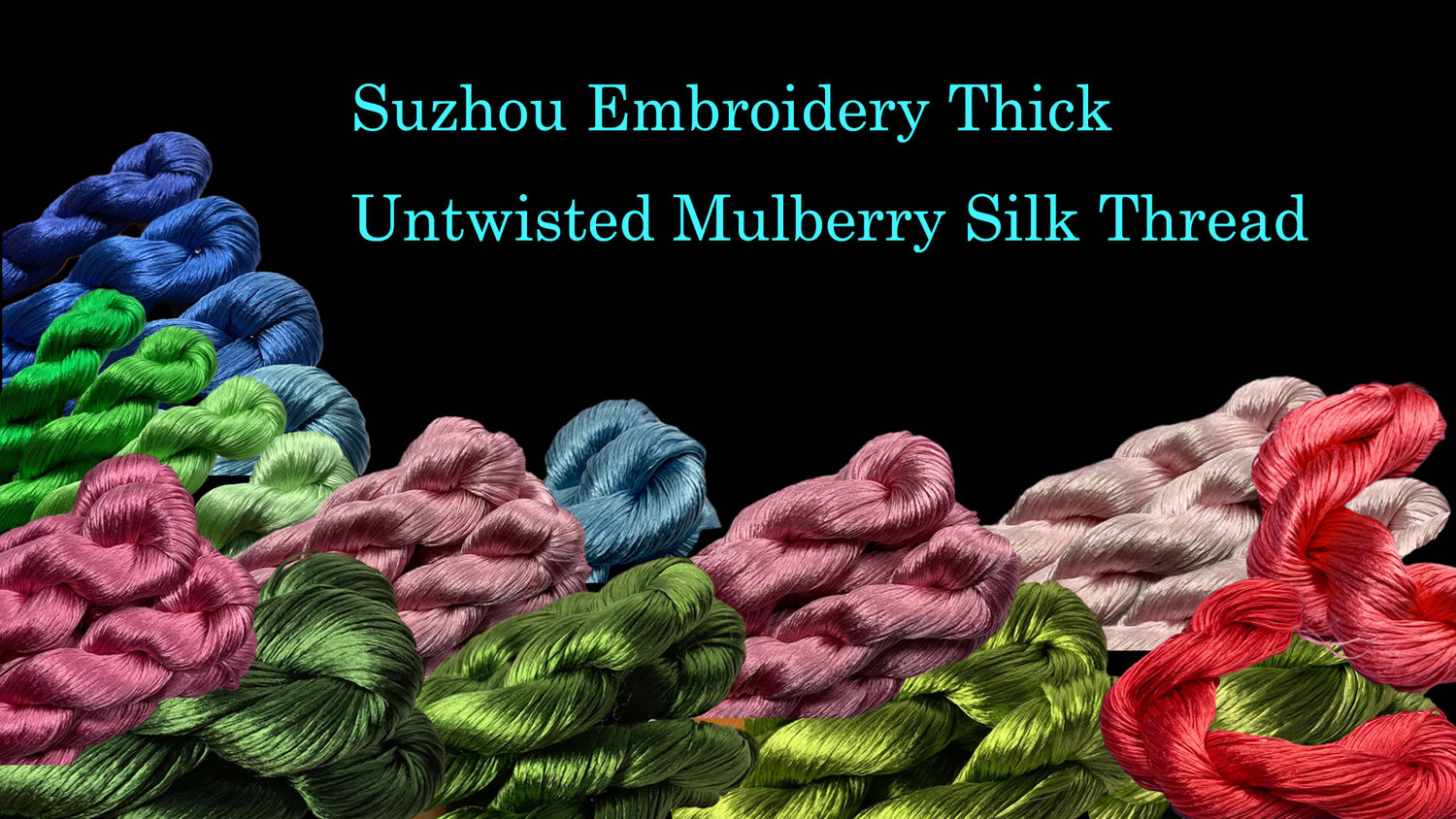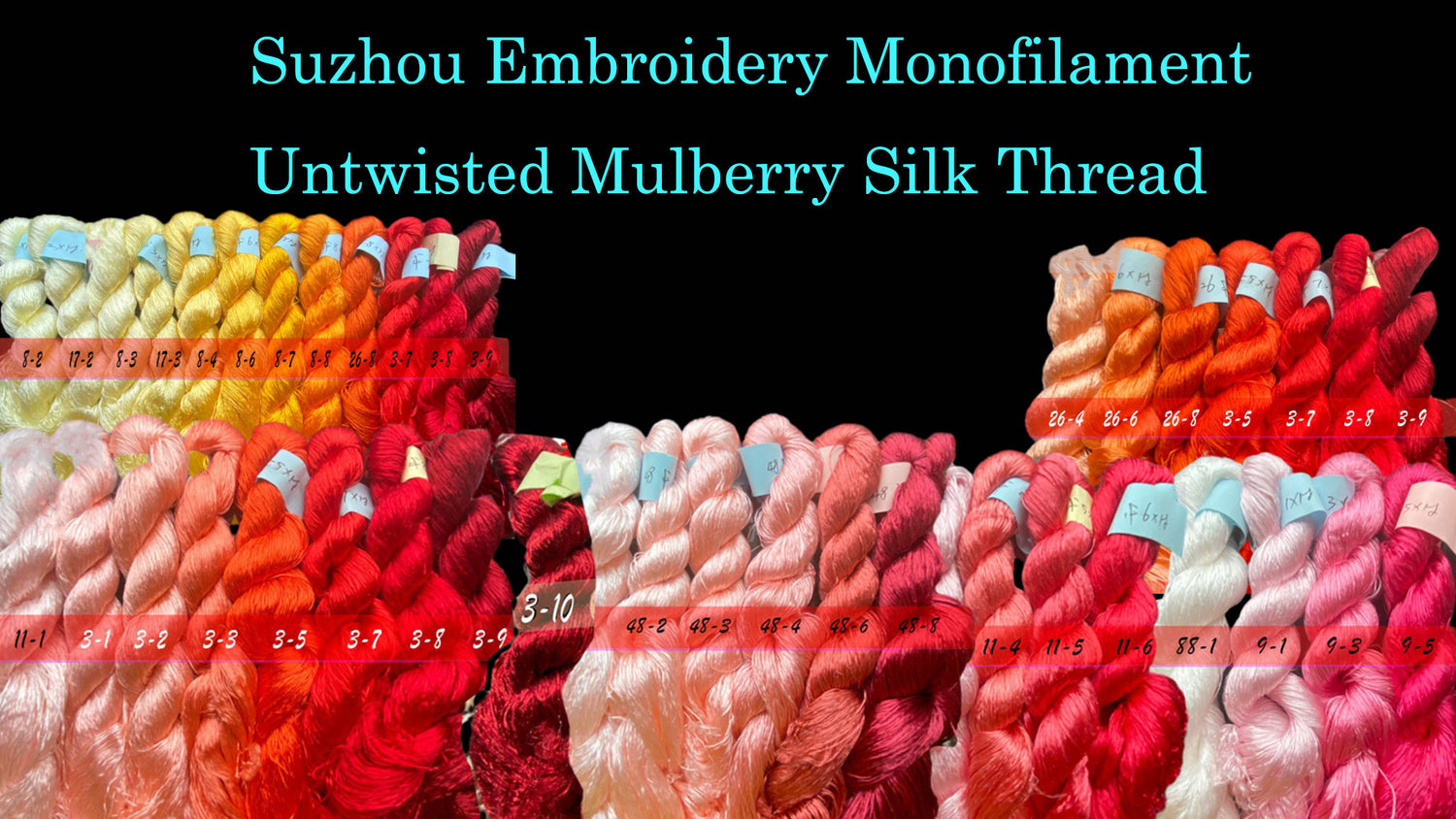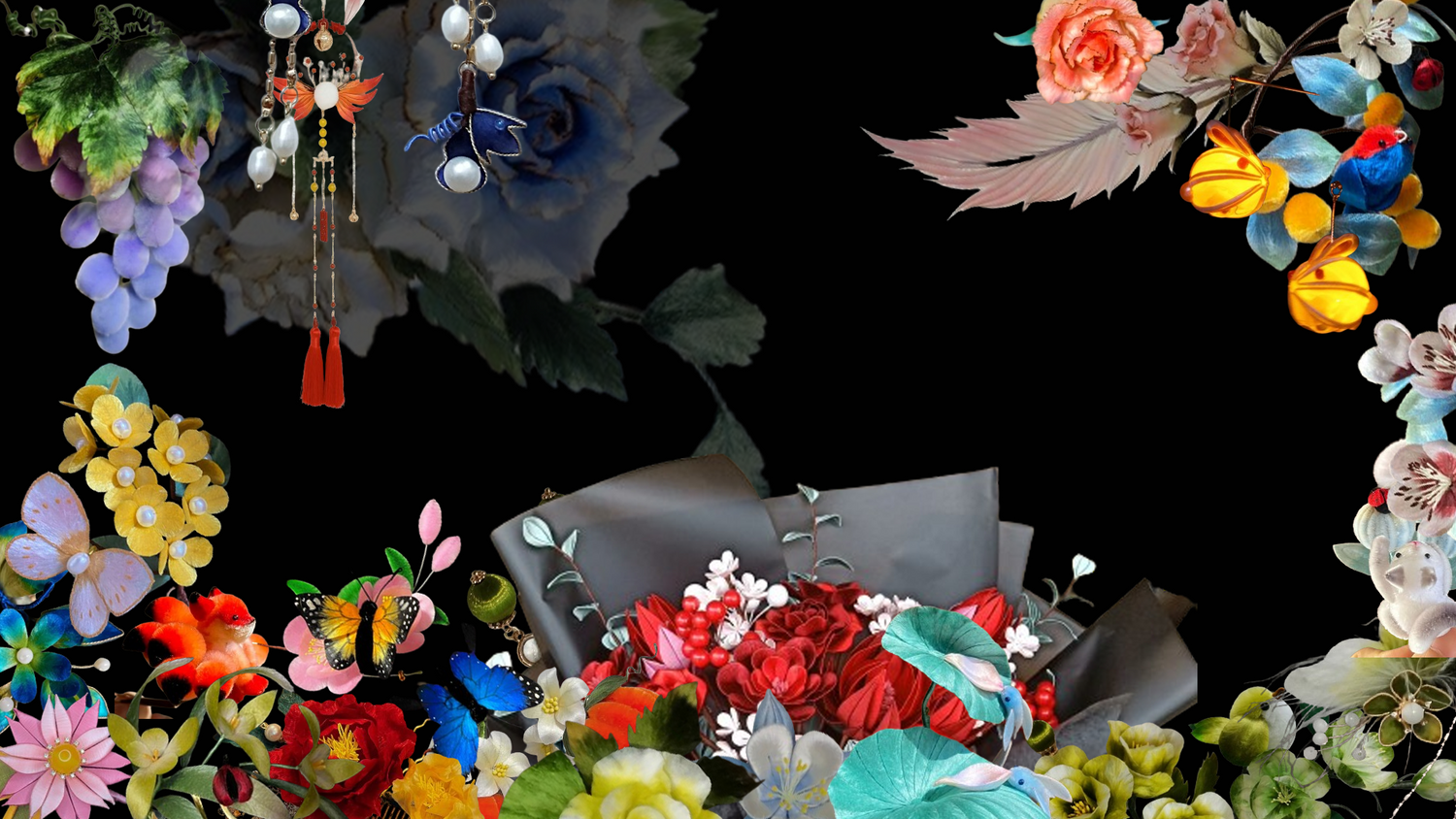
How to Make a Butterfly Peony Chanhua Ornament - Handcraft Chanhua Tutorial
Share
The peony flower is the main part of this Chanhua. When making it, we need to combine petals of different sizes, resulting in a staggered and elegant flower shape that is both grand and intricately decorated. This section will introduce the steps for making the peony flower.
A. Materials and Tools
- - White cardstock
- - Carbon pen
- - Scissors
- - Red silk threads
- - No. 30 silk flower wire
- - White glue
- - Edge sealer
- - Seed beads
- - Tarnish-resistant copper wire
- - Cotton strips
- - Colored pens
B. Making the Bud
 1
1
1. Use a carbon pen to draw the pattern of medium-sized petals on white cardstock, ensuring the petals are symmetrical. Cut along the lines with scissors. Take a silk thread, split it, and recombine it for use.
 2
2
2. Take a piece of wire, hold it with your left hand, and wrap the silk thread around it from left to right for about 1 cm, then wrap from right to left to start.
 3
3
3. Place the cardstock on top of the wire and continue wrapping from right to left. The curvature of the wrapping varies at different positions on the petal, so always keep the silk thread tight during the process.
 4
4
4. If the silk thread runs out while wrapping, splice the new thread by folding it in half, looping it through the end of the wire, and tightening it, slightly covering the previously wrapped thread, then continue wrapping until the entire flower is done.
 5 6
5 6
5. Use a carbon pen (or a cylindrical tool like chopsticks) to wrap the finished petals around the pen body, forming a natural surrounding shape. The two petal tips should meet and be fixed with white glue, then wrap a few more times with silk thread to cover the glue marks.
6. Combine the tips of the petals’ wire and tightly wrap them with silk thread to form a flower stem for easy assembly later. Repeat to make three such medium petals and combine them with their concave sides facing inward to form a bud.
C. Making Petals of Three Sizes
 1
1
1. Draw the pattern of small petals on cardstock and cut them out. Wrap the small petals with wire and silk thread using the same method. Only one wire is needed for small cardstock pieces.
 2 3
2 3
2. Use a carbon pen to shape and fix eight small petals, dividing them into two groups, one with three petals and one with five petals.
3. Use the same method to make five medium-sized petals, only using one wire for each petal.
 4
4
4. Large petals need more support, so use two wires for each large petal.
 5
5
5. Make ten large petals. Apply edge sealer to the bottom of the petals and wait for it to dry completely. Combine the petals in pairs to form five groups. When attaching, ensure the two petals are "back to back," slightly offset from each other.
D. Making the Peony Stamen
 1
1
1. Take a 1.5-meter long tarnish-resistant copper wire, string seed beads onto it, and slightly separate the end bead from the others. Thread the wire end through the top of the end bead and tighten it, securing the bead at the end, then move the other beads towards the end.
 2
2
2. Slightly separate the top bead from the others, thread the top copper wire through the second bead from the top, then through all the beads in sequence, tightening the wire. One stamen is now complete.
 3
3
3. Repeat steps 1 and 2 to make eleven stamens.
E. Assembling the Peony Flower
 1
1
1. Apply white glue to the bottom of the previously made bud and add a cotton strip, wrapping it around the base of the flower stem.
 2 3
2 3
2. Use colored pens to color the cotton strip, making it more harmonious with the peony flower.
3. Take three small petals and wrap them around the bud and cotton strip, positioning the petals similarly to the bud.
 4
4
4. Add the prepared stamens to the outer side of the small petals, ensuring the stamens are evenly distributed.
 5
5
5. Add five small petals to the outer layer, adjusting their positions to create a staggered look.
 6
6
6. Add five groups of large petals to the outermost layer, with the concave sides facing outwards. Ensure the petal bases are attached to the flower root.
 7 8
7 8
7. Fix the previously separately made five medium petals in the middle of each large petal group.
8. Fold the protruding stamens back and tuck them randomly into the peony flower.
6.7.2 Making the Butterfly
The butterfly is an important decorative part of this Chanhua. To showcase the various forms of butterflies and make the overall Chanhua look more vibrant and rich, we use different methods to make the butterflies. This section will introduce the methods for making five different butterfly styles.
A. Materials and Tools
- - White cardstock
- - Carbon pen
- - Scissors
- - Red, fluorescent red, blue, and yellow silk threads
- - No. 30 silk flower wire
- - Edge sealer
- - Wooden stick
- - Seed beads
- - Decorative metal wire
- - Wire winding board
- - 0.5mm diameter copper wire
- - 0.3mm diameter tarnish-resistant copper wire
B. Making Butterfly Style 1
 1 2
1 2
1. Use a carbon pen to draw the patterns of the upper and lower wings of Butterfly Style 1 on white cardstock. Wrap the patterns with red silk thread, noting that the upper wings should be larger than the lower wings, and the outer edge length of the lower wings should roughly equal the inner edge length of the upper wings.
2. Apply edge sealer and fix the silk thread, then use a wooden stick to adjust the shape of the butterfly wings, making the wing surface streamlined according to the side curvature.
 3
3
3. Make another set of wings using the same method, ensuring the wings are symmetrical. Assemble the wings together and use the method described in the previous section for making peony stamens to create the butterfly's antennae.
C. Making Butterfly Style 2
 1
1
1. Draw the pattern of two upper wings of Butterfly Style 2 on white cardstock and cut them out with scissors. Wrap the upper wings with silk thread, apply edge sealer, and use a wooden stick at the back edge of the upper wings to bend the edges backward into a curled shape, as shown in the diagram.
 2
2
2. Draw the pattern of two lower wings of Butterfly Style 2 on white cardstock and cut them out with scissors. Wrap the lower wings with decorative metal wire, as shown in the left diagram.
 3
3
3. Assemble the four wings together and make antennae for Butterfly Style 2 using the same method as in Butterfly Style 1. The result is shown in the diagram.
D. Making Butterfly Pattern 3
 1 2
1 2
1. Draw the left upper wing of Butterfly Pattern 3 on white card paper. Ensure that the upper wing is pointed at both ends, rounded in the middle, and relatively wider at the "1" and "4" ends, while the "2" and "3" ends are sharper and thinner. Cut along the lines with scissors to get two pieces of card paper. The upper wings of Butterfly Pattern 3 will use the two-color controlled wrapping method, so prepare red and blue silk threads and split them.
2. Hold the wire and blue silk thread in your left hand. Start with the red silk thread on the wire and blue silk thread with your right hand, add the paper pattern, and continue wrapping with the red silk thread for about 5mm. Then, wrap the red silk thread to the back of the paper pattern and secure it with the wire.
 3
3
3. Continue wrapping with the blue silk thread. After wrapping three times, wrap it to the back of the white card paper and secure it with the wire.
 4
4
4. Refer to steps 2 and 3, alternately wrapping with red and blue silk threads. When wrapping one color, ensure the other color silk thread remains flat, and pay attention to the overlap of the two-color silk threads on the front side.
 5
5
5. After wrapping is complete, take the other piece of white card paper and continue wrapping using the two-color controlled wrapping method to keep the colors at both ends of the upper wings consistent.
 6 7
6 7
6. Once the entire upper wing is wrapped, bend it at the center joint, bringing the ends together and securing them with silk threads.
7. Draw the lower wing pattern on white card paper and cut along the lines. Wrap it with red silk threads and attach it to the upper wing. Repeat the above steps to complete the production of the right upper and lower wings, and use seed beads and wire to make the antennae of Butterfly Pattern 3.
 Random wrapping method effect Controlled wrapping method effect
Random wrapping method effect Controlled wrapping method effect
Tip: The above picture shows a comparison between the two-color random wrapping method and the two-color controlled wrapping method.
E. Making Butterfly Pattern 4
 1 2
1 2
1. Draw five elongated patterns resembling leaves with slightly pointed ends on white card paper. Each pattern consists of two symmetrical pieces of card paper. Cut along the lines to get ten pieces of card paper. Divide them into two groups, one with four pieces and the other with six pieces. Wrap them accordingly, ensuring that after wrapping two symmetrical pieces, their ends meet and are secured with silk threads.
2. Assemble the two groups of paper patterns with silk threads, making the wrapped flower shape resemble a five-petal flower. Hold the "five-petal flower" as shown in the picture, with one "petal" positioned alone at the top and the remaining four symmetrically arranged as the four wings of Butterfly Pattern 4.
 3 4
3 4
3. Fold the single petal back from the top, use a stick to prop open the gap in the middle of the upper wings from below for a three-dimensional effect, and fold the tips of the lower wings downward.
4. Bend the two wires in the "five-petal flower" forward and continue wrapping with the same color silk threads to make the antennae of Butterfly Pattern 4, threading a seed bead onto the tip of each antenna.
F. Making Butterfly Pattern 5
 1
1
1. Place four posts on the winding board. Take a 20cm long, 0.5mm diameter copper wire and wrap it with silk threads. Pull the copper wire from the left side of post 1, wrap it around post 1, then around post 2.
 2 3
2 3
2. Wind the copper wire counterclockwise over the top of post 3, through the left side of post 1, to the bottom of post 4, and wind counterclockwise around post 4. Then, wind clockwise around post 1 from the bottom, with both ends of the copper wire meeting.
3. Remove the copper wire to form the right wing of Butterfly Pattern 5. Take another copper wire and make the left wing using the same method, ensuring the wings are symmetrical, completing the butterfly model.
 4 5
4 5
4. Take a 90cm long, 0.3mm diameter color-preserved copper wire, fold it in half, and randomly thread seed beads onto the single wire, then twist tightly.
5. Secure the color-preserved copper wire to the butterfly model made in steps 1-3, adjusting the wire shape to match the butterfly model.
 6
6
6. Stretch the remaining color-preserved copper wire to the top of the butterfly and fold it back, securing the end in the center of the butterfly.
 7
7
7. Cut the center top of the color-preserved copper wire and bend the two cut ends outward.
G. Making the Required Number of Butterflies
 1
1
1. Refer to the steps for making each butterfly pattern, adjusting the silk thread colors as desired, and make two Butterfly Pattern 1s, one Butterfly Pattern 2, two Butterfly Pattern 3s, five Butterfly Pattern 4s, and two Butterfly Pattern 5s.
2. Group and place them for easy access.
6.7.3 Making Flower Stems and Assembling Butterflies
Making flower stems is not complicated, but to simplify the process and avoid repetition, we need to assemble the butterflies while making the flower stems. This section will introduce the steps for making flower stems and assembling the butterflies.
A. Materials and Tools
- - 30-gauge wire for silk flowers
- - Dark silk threads
B. Making and Combining
 1 2
1 2
1. Take ten 80cm long wires, start wrapping with silk threads at the wire's end with your right hand.
2. Fold the wire end back to align with the rest of the wire, wrapping the unwound wire end onto the wire to form an arc-shaped tail. This prevents the silk threads from slipping off and avoids the wire end being too sharp and causing damage.
 3
3
3. Secure the prepared butterflies onto the wire one by one in a random order, ensuring they are evenly distributed. The wire should be fully wrapped with silk threads to make two flower stems of different lengths.
6.7.4 Overall Assembly
After completing all the components, proceed with the overall assembly. This section will introduce the specific steps for integrating and assembling the components.
A. Materials and Tools
- - Liquid pearlescent watercolor pen
- - Dark silk threads
- - 30-gauge wire for silk flowers
B. Assembly

1
1. Make a flower stem with wire and dark silk threads, secure the peony flower onto this stem, and wrap the stem with silk threads and the two previously made flower stems.

2. Center the peony flower and arrange the butterfly-adorned flower stems around it.
 3
3
3. Adjust the overall shape of the wrapped flowers and apply the liquid pearlescent watercolor pen to the butterflies to create an atmospheric effect.
 Finished Product Display
Finished Product Display







